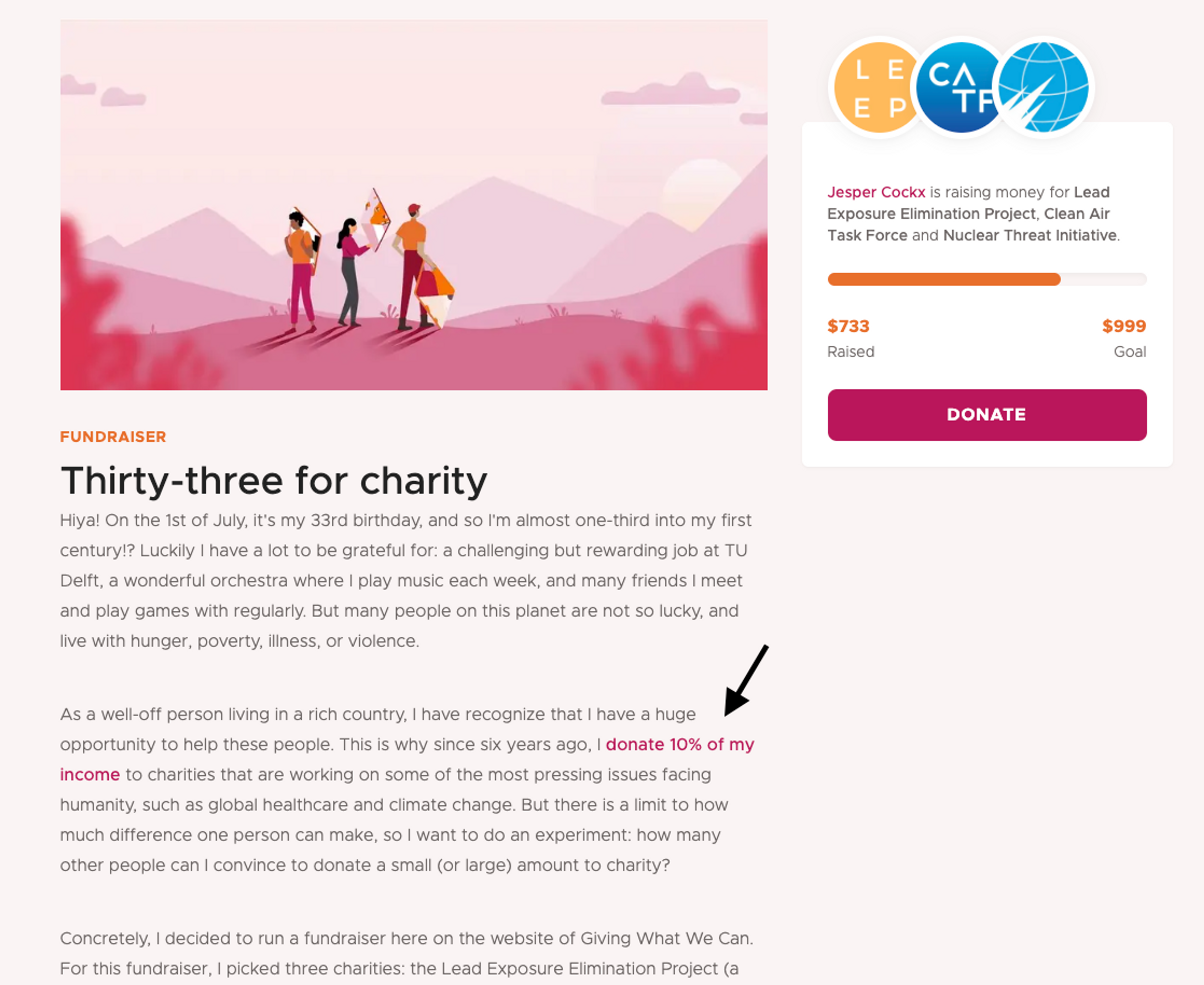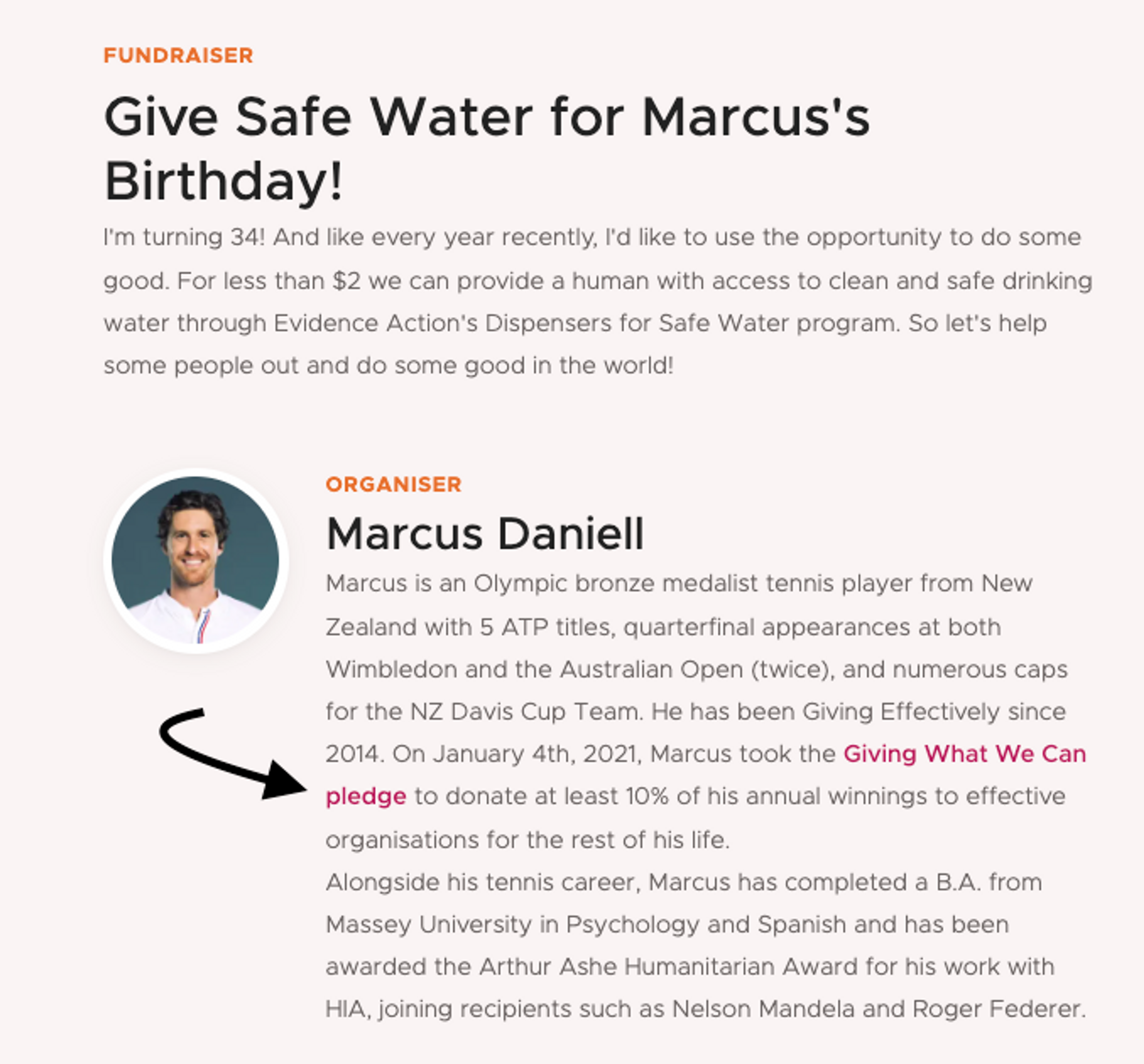Fundraise for effective charities
Running a fundraiser is a great path to impact. Not only are you driving more resources to high-impact causes, but you're also spreading awareness about effective giving!

We hear from many Giving What We Can pledgers that they wish more people knew about effective giving but that it can be difficult to broach the subject with family and friends. Creating and sharing a fundraiser can be an effective and approachable way to start the conversation!
Here, we cover the basic "whys" and "hows" of running a fundraiser. We also provide some insider tips for getting the word out, personalising your call to action, and having fun along the way.
Looking to run a birthday fundraiser? Check out this this guide.
Why you should run a fundraiser
Perhaps you are on the global rich list, and so are the people around you. Yet most of your friends don't give much money to charities. Maybe they have been blunted by the countless moral appeals by TV ads or pushy charity salespeople. So, what if you could offer your friends a quick and easy way to do good?
Running a fundraiser will help you live up to your values by mobilising money towards causes you care about, and getting your friends involved too. With only a few hours of effort, GWWC members have raised hundreds --- even thousands --- of dollars at a time using fundraisers.
If you've taken the Giving What We Can pledge, running a fundraiser is also a great way to spread the word to those who may be interested. Add a mention of the pledge into your fundraiser description and/or into your organiser bio! (See examples below).
How to run a fundraiser
1. Choose a charity or fund
The first step is to choose an effective charity or fund to support. We recommend you choose just one to ensure that you're sending a strong, clear message about what you support. If you're using this fundraiser as a conversation starter, consider choosing an organisation that you think is particularly helpful in demonstrating some core effective giving concepts.
- If you're having trouble deciding, we recommend choosing a cause area that resonates with you and then picking from one of our recommendations in that cause area. We think all of our recommendations are fantastic giving opportunities, so don't let decision fatigue stop you from getting started!
2. Choose a timeline
- Choose when you want to launch your fundraiser and how long you want to run it for. You'll want to choose a long enough time frame that you can meet your goal, but not so long a time frame that your participants won't feel a sense of urgency. 10-14 days is probably a good rule of thumb.
- Consider choosing a launch time that has some significance -- for example, perhaps you want to fundraise around a particular holiday, commemorative event, or the anniversary of something meaningful that happened in your life. If you can't think of anything, it's perfectly fine to choose any date!
3. Craft your message
After selecting a charity and timeline, you can prepare the message you want your friends, family, and other potential donors to see. Explain why you're running the fundraiser, why you care about the organisation, and anything else you want potential donors to know! Keep it short and speak from the heart. You'll need a message for:
- The fundraiser description
- Reaching out to friends and family to let them know about your fundraiser (tips below)
4. Set up your fundraiser
Choose a platform that makes it as easy as possible for your friends and family to donate to your selected charity or fund. We cover some options below; depending on your circumstances, there may be other options available too.
Option 1: Set up a fundraising page with us! (Recommended):
Choose up to 3 charities or funds that are on our platform. Then include a description, image and more!
Submit a fundraising page request

An example of one of our fundraising pages -> full page here
See more examples
Option 2: Set up a Facebook fundraiser
Facebook allows you to create fundraisers for many effective charities. As a social media site, Facebook also makes it easy to get the word out. You can post the fundraiser on your timeline, share it with friends, and even encourage them to share it as well with one easy click.
(Please note: If you are planning to create a fundraiser for Effective Ventures Foundation, donations through Facebook fundraisers are defaulted to unrestricted general use if they are lower than $10K GBP/USD in value.)
Option 3: Use the charity's website
If you're planning to reach out to potential donors over email, you can send people directly to a charity's website and ask them to make donations there. Some charities (e.g., AMF) even allow you to set up your own fundraising page, which will track what you've raised. If you've selected a charity without the fundraiser feature, you might want to ask your friends to report their donations to you, so that you can keep track.
Option 4: Use your account and donate to the charity in one go.
You can ask friends and family to send their donations directly to you, either in cash or using an app like Venmo or Paypal. With these apps, friends can send you their donation without the extra step of visiting the charity's website and entering their payment information. Depending on your home country, you may be eligible for tax benefits on the total amount you collect and donate. However, asking your friends to send you money directly does require a high degree of trust.
5. Contact friends and family
Asking your friends and family for donations can feel awkward. Some may not be open to donating or are not in a position to do so. In your messaging, always make clear that a donation is voluntary. Here are some tips for thinking about this:
- You will likely find that most people are more than happy to chip in. Seen from their perspective, you have vetted a charity and provided them with a quick opportunity to do good.
- Don't be shy about casting a wide net. Donations can sometimes come from unexpected places, and people in your extended network might be very supportive.
- For closer contacts, consider sending a personal message to each person. While it takes more time, the response rate is often much higher. (You could also send one group message to all your friends or do both -- send a personal message to some of your contacts and a group message to a larger group.)
- There is no "right" or "wrong" number of people to contact; do what you are most comfortable with. In the past, GWWC members have contacted anywhere from a handful of close friends to hundreds of people in their networks.
Crafting a strong message
A message with a personal touch can be very successful in soliciting donations. A personalised message will usually begin with a short note customised to each friend. The text about your charity should be written from your perspective, rather than, say, copied from the charity's website.
For instance, if you have kids, you might mention that parental love is part of your motivation for donating bed nets to protect children from malaria.
There are other aspects to crafting a compelling message. One is to provide a concrete example or story about something your selected charity has accomplished. Another is to reassure someone of the effectiveness of your charity, perhaps noting if it's been vetted or featured as a recommended charity by a credible organisation.
No matter the exact contents of your message, what is most powerful is that you reached out and offered your friends an opportunity to do good.
Finally, consider recording and distributing a short video message with a link to your donation page. These can be even more personal and mobilising, though they may take more time.
Hi {Name},
I hope all is well in {location}. I've heard great things about the city. How have you been?
I wanted to let you know about a fundraiser I'm running for a great cause.
I'm a member of an organisation called Giving What We Can (GWWC). It's a community of people who are dedicated to using evidence and reason in their donation decisions. GWWC points out that donating to some charities can be 100x more impactful than others. They recommend a number of highly effective charities, and this year I've decided to raise funds for {Charity Name}.
{Include a brief description of the charity and why you chose it}
If you want to donate, you can do this via {link to your fundraising page or charity website}.
I completely understand, of course, if you're not able to donate at this time. I also just wanted to check in with you and would love to know how you're doing.
Love,
{Name}
P.S. The fundraiser will conclude on {Date} and I will let you know how much money we've raised.
We recommend sending your message however you normally interact with your friends, be it email, WhatsApp, Facebook Messenger, or any other avenue.
More message examples
We've decided to crowdsource examples of messages that our members have used! If you have held a fundraiser or similar event and are willing to share the message you used with others in the community, please fill out this form.
As we receive them, form responses will be available in this spreadsheet.
Additional tips for running a successful fundraiser
Remind your friends about your fundraiser.
Maybe they missed your first message or were just too busy to respond immediately. We recommend sending a reminder two or three days before the fundraiser closes.
Publish your fundraiser on social media.
By using social media, you can reach even more friends who might contribute to your fundraiser. And if you post there a day before you start messaging friends, you may already have a confidence-boosting donation in the bag.
Celebrate your success.
Be proud of the money that you've raised. Talk about it! And message everyone again when the fundraiser has ended with the final tally. If possible, be concrete about the impact you've collectively had -- say how many bed nets the fundraiser provided or how many families your donors were able to protect all together.
Consider matching donations.
There is some evidence that offering to match your friends' donations will increase the likelihood and amount that they donate. Feel free to set a limit to your matching offer; for instance, you could offer to match all donations up to $1,000. If you've made a giving pledge, you could count your matching campaign as part of your pledge.
Mix it up.
If you're running a second fundraiser, why not make it a bit more interesting by adding a challenge? For instance, you can do a push-up for every $2 raised, run a mile for every $20, or record yourself singing a song for every $200.
Mentioning your pledge
If you want to help raise awareness about the giving pledge, consider mentioning it in your fundraiser description and/or bio! Here are some examples:

